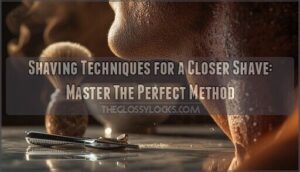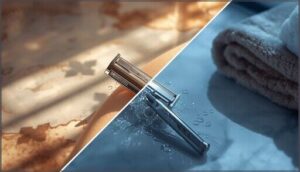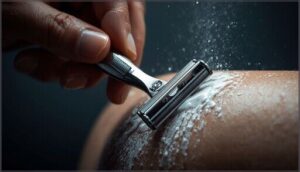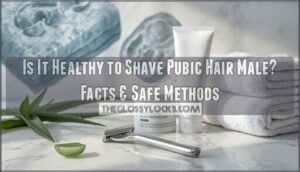This site is supported by our readers. We may earn a commission, at no cost to you, if you purchase through links.
Most men waste decades dragging dull blades across their face, wondering why they can’t match the smoothness their barber delivers in minutes. The gap between a mediocre shave and a professional-grade result isn’t about expensive gear or secret products. It comes down to technique.
Proper shaving techniques for a closer shave rely on preparation, blade angle, and consistent pressure. When you soften hair with warm water, follow the grain on your first pass, and stretch your skin correctly, you cut resistance and eliminate irritation.
These fundamentals transform your routine from a daily chore into a skill you control. Master the method, and you’ll feel the difference every time your hand touches your face.
Table Of Contents
Key Takeaways
- Proper preparation with warm water hydration for two minutes and pre-shave cleansing cuts hair resistance by 65% and sets the foundation for a smooth, irritation-free shave.
- Sharp blades at a 30-degree angle combined with short, light strokes and multi-pass techniques deliver barbershop closeness without razor burn or ingrown hairs.
- Stretching skin correctly and shaving with the grain first, then across, then cautiously against prevents follicle trauma and keeps emerging hair from retracting under the skin.
- Post-shave care with cold water rinsing, alcohol-free moisturizers, and daily SPF 30 protection locks in results and prevents long-term skin damage.
Preparing Your Skin for a Closer Shave
Your skin is the foundation of every great shave, and you can’t skip the prep if you want results that last. The right steps before you even pick up a razor make the difference between a smooth finish and a face full of irritation.
Let’s break down the essentials you need to master before your blade touches skin.
Importance of Hydration and Warmth
When you soften your facial hair with warm water, you cut through 65% less resistance. Laboratory data shows beard hair reaches full hydration in about two minutes when exposed to warm water—enough time for the hair shaft to swell and become pliable. That makes every stroke smoother.
Warm water softens facial hair in two minutes, cutting resistance by 65% and making every stroke smoother
Hydrating before shaving also strengthens your skin barrier, so you’ll face less irritation and tightness afterward. Using shaving cream with ingredients like aqua and glycerin can further boost skin hydration levels.
Cleansing and Exfoliating Techniques
Once your hair is hydrated, pre-shave cleansing removes oil and bacteria that clog blades. Only 35% of younger men wash their face daily before shaving—don’t skip this step. Exfoliation lifts follicles and clears dead cells for a smoother pass. Use these integrated routines:
- Wash with a gentle facial cleanser and warm water.
- Apply chemical exfoliants like salicylic or lactic acid two to three times weekly.
- Try mechanical exfoliation with light circular motions for 30 seconds.
- Wait 12 hours after shaving to exfoliate again.
- Choose your exfoliation cream based on skin type—chemical for sensitive areas, physical scrubs for tougher zones.
This sequence minimizes razor burn and ingrown hairs while maximizing blade contact. An important step is a proper pre-shave ritual for a closer shave.
Pre-shave Treatments for Sensitive Skin
Sensitive skin demands a barrier-first strategy before any blade touches your face. Pre-shave treatments using emollient benefits like glycerol-based gels hydrate and shield against friction. Aloe vera soothes inflammation while botanical oils—think chamomile or rosehip—calm redness. Build your regimen structure around irritant avoidance: skip fragrances and alcohol.
Here’s your skin conditioning foundation:
| Treatment Type | Key Action |
|---|---|
| Glycerol emollients | Lock in moisture, prevent water loss |
| Aloe vera gels | Reduce erythema, antibacterial protection |
| Botanical carrier oils | Anti-inflammatory, barrier repair |
Patch-test any new preshave product. Your skin preparation ritual determines your shave’s outcome—don’t rush it.
Choosing The Best Shaving Tools
Your tools determine how close you shave. A quality razor paired with the right blade and cream can mean the difference between a clean face and a frustrating morning.
Let’s break down what actually works.
Types of Razors for Close Shaves
Your razor is the commander of your shave—choose wisely and closeness follows. Each razor type delivers different results, and knowing what you’re holding changes everything.
- Safety razors use a single double-edge blade at about 30 degrees, cutting efficiently while reducing ingrown hairs compared to multi-blade cartridge razors
- Cartridge razors pack 3–5 blades for faster smoothness but can increase friction and irritation
- Straight razors cut at or below skin level when paired with proper stretching and shallow angles
- Electric shavers prioritize convenience over maximum closeness, with foil types performing better on flat areas
- Hybrid razors combine pivoting heads with replaceable blades, balancing barbershop closeness with everyday comfort
Selecting The Right Blades
Sharpness decides your fate—an edge radius below 0.2 microns cuts like a scalpel, while angles above 25 degrees leave you scraping instead of slicing. Stainless steel blades deliver durability, but high-carbon options give unparalleled sharpness if you keep rust at bay.
Replace cartridges every 5–7 shaves and safety razor blades after 7–10 to avoid irritation from a dull blade that tugs and burns.
Shaving Creams, Soaps, and Brushes
The cushion between steel and skin makes the difference. Quality shaving cream and soap generate dense, stable lather that softens whiskers and protects against razor burn far better than cheap aerosols.
- Creams build faster, softer lather ideal for sensitive skin with higher water content
- Soaps last longer and provide enhanced lubrication through multiple passes
- Brushes lift stubble mechanically while exfoliating, creating uniform coverage across every contour
Mastering Effective Shaving Techniques
You’ve got the right tools, so now it’s time to put them to work. The way you move the razor across your face makes all the difference between a close, clean shave and a day spent dealing with irritation.
Let’s break down the techniques that separate a good shave from a great one.
Shaving With The Grain Vs. Against
You’ve got two paths to achieving a close shave: shaving with the grain or against it. Shaving with the grain follows your hair growth direction and delivers strong irritation reduction. Going against the grain cuts closer but raises the risk of razor bumps and ingrown hairs.
For safety protocols, start with the grain. Multi-pass benefits shine when you layer passes—with, across, then cautiously against—to balance closeness comparison with skin protection.
Using Short, Light Strokes
Control is everything when you’re chasing that perfect shave. Short strokes and light pressure give you mastery over the blade—no dragging, no forcing, just clean passes. Barber training shows best razor strokes stay around 2–3 cm for precision control. These shaving techniques deliver risk reduction and better blade cleanliness while achieving a close shave without battle scars.
- Keep each stroke short—about an inch at most
- Let the razor’s weight do the work
- Rinse every few passes to clear trapped hair
- Move deliberately, not rushed
Stretching Skin and Angle Control
You want a smooth shave without the bumps—then master the balance between blade angle and skin tension. Hold the razor at 30° to the skin for clean cuts and minimal drag.
Light stretching steadies the surface for better razor strokes, but overdoing it raises pseudofolliculitis risk by letting hair retract under the skin. Angle-pressure balance separates barbershop-smooth from backyard butchery.
Multi-Pass Shaving for Extra Smoothness
A smooth shave isn’t about brute force—it’s about progressive refinement. Start with-the-grain, then move across-the-grain for extra closeness while preserving your skin barrier.
Re-lather before every pass to reduce irritation and erythema. Multiple gentle strokes beat one aggressive swipe for hair removal outcomes without razor bumps.
This shaving technique transforms good into barbershop-smooth—mastery over mayhem.
Preventing Irritation and Ingrown Hairs
A close shave shouldn’t leave your face angry and covered in bumps. The difference between smooth skin and razor burn comes down to a few key habits that protect your face during and after each pass.
Let’s break down the exact steps that keep irritation at bay and stop ingrown hairs before they start.
Minimizing Razor Burn and Bumps
Preventing razor burn starts with respecting your skin’s natural defenses. Sharp blades reduce the need for repeated passes, which keeps skin irritation at bay. When you shave in the direction your hair grows and apply gentle pressure, you avoid dragging the blade or forcing cut hairs below the follicle opening.
- Replace cartridges after five to seven uses to maintain blade sharpness
- Use a lubricating gel or foam to improve lubrication quality and reduce friction
- Shave with the grain on your first pass to follow proper hair direction
- Keep strokes light and avoid stretching skin excessively to minimize trauma
Limiting shaving frequency to every 24 to 48 hours gives inflamed follicles time to recover. This approach dramatically lowers your risk of razor burn and prevents skin irritation in susceptible areas.
Exfoliation Methods Before and After Shaving
Regular exfoliation keeps your follicles clear and slashes the risk of ingrown hairs by removing dead skin cells that trap emerging stubble. Mechanical exfoliation with a warm cloth or gentle scrub lifts debris before shaving, while chemical exfoliation using glycolic or salicylic acid loosens buildup without friction. Timing exfoliation matters—apply keratolytics between shaves, not on freshly irritated skin, to support long-term prevention and healthier facial skin.
| Exfoliation Type | When to Use |
|---|---|
| Mechanical scrub | Before shaving |
| Glycolic acid | Between shaves |
| Salicylic acid peel | Non-shave days |
Proper Razor Maintenance and Hygiene
Your blade maintenance determines how long each edge stays sharp and safe. Rinse thoroughly under warm water after every stroke to clear trapped hair and product, then shake off excess moisture before air-drying in a ventilated spot—never blade-down on wet surfaces.
Disinfection methods like soaking in 70% isopropyl alcohol for five minutes slash bacterial load and prevent cross-contamination, extending blade lifespan while protecting your skin from infection.
Post-Shave Care for Smooth, Healthy Skin
Your shave doesn’t end when you rinse the blade. What you do in the next few minutes determines whether your skin feels smooth or suffers for days.
Let’s cover the essential steps that lock in your results and keep your face healthy between shaves.
Rinsing and Drying Correctly
Rinsing off shaving cream isn’t where you stop—it’s where you set up the next step in your shaving routine. Use a cold water rinse to close pores and calm skin. Quick, thorough rinsing beats long exposure. Then pat your face dry with a clean towel instead of rubbing.
- Water temperature matters: Cool or cold water reduces redness better than warm water after you shave
- Rinsing duration: Keep it brief but complete to remove all product and loose hairs
- Pat drying wins: Pressing the towel gently causes less irritation than dragging it across skin
- Towel hygiene counts: Always use a fresh, clean towel to avoid transferring bacteria to vulnerable skin
- Complication reduction: Proper rinsing and drying prevent razor bumps and folliculitis before they start
This simple shaving tip protects the closeness you just achieved.
Applying Aftershave and Moisturizer
After you pat dry, reach for a balm or lotion instead of alcohol aftershaves—they won’t spike water loss or delay your skin’s pH recovery.
Apply moisturizer immediately while pores are closing. Noncomedogenic formulas with soothing ingredients like aloe or niacinamide support barrier repair and prevent complications like razor bumps.
Using aftershave balm twice daily keeps results smooth and irritation-free.
Sun Protection and Ongoing Skin Care
Beyond moisturizer, add broad-spectrum SPF 30 every morning—shaving strips away natural UV protection and leaves your skin thinner and more reactive. Daily SPF is your defense against sunburn, hyperpigmentation, and long-term photodamage.
Wait fifteen minutes after shaving before sun exposure so irritation settles. Apply generously to all shaved areas, reapply during outdoor activities, and make sun protection a locked-in habit for healthier skin over time.
Frequently Asked Questions (FAQs)
How often should I replace my razor blade?
You’ll know it’s time when tugging replaces smooth glides. Most cartridges last about five to seven shaves—but coarse beards and daily use cut that timeline shorter.
Can shaving frequency affect closeness and irritation?
Shaving frequency directly impacts both closeness and irritation. Daily shaving raises irritation risk, especially for sensitive skin. Giving skin recovery time between shaves reduces razor burn while maintaining smooth results.
What diet changes improve skin health for shaving?
Low-Glycemic Diets clear your skin; Dairy and Irritation trigger bumps; Omega-3 Modulation calms redness; Micronutrient Support speeds healing; Gut-Skin Axis balances inflammation.
Each step fortifies skin health, making shaving and skin care smoother and more predictable.
Does water temperature after shaving really matter?
Yes, water temperature matters. Cold water reduces inflammation and redness through vasoconstriction while preserving your skin barrier. Warm water can strip natural oils and worsen irritation.
Rinse cool, then moisturize immediately postshave for best skin protection.
Should I shave before or after exercising?
After your workout wins every time. Sweat and friction hit freshly shaved skin hard, triggering post-shave irritation and worsening skin barrier damage.
Warm water after exercise softens hair and preps your face perfectly.
Conclusion
A dull blade scraping over unprepared skin is like dragging a rake through concrete—you’ll never get the result you want. Shaving techniques for a closer shave aren’t about luck or genetics. They’re about control.
When you hydrate properly, maintain sharp tools, and execute each stroke with intention, you transform your routine from guesswork into precision.
Stop settling for mediocre results. Take command of your technique, and your face will show the difference every single day.
- https://www.reddit.com/r/wicked_edge/comments/1b9abz4/hot_or_cold_shave/
- http://www.pimaderm.com/wp-content/uploads/2018/07/Pseudofolliculitis_Shaving_Methods.pdf
- https://leafshave.com/pages/the-razor-study
- https://www.intrinsicshaving.com/post/unveiling-the-disparity-single-blade-vs-multi-blade-razors-by-mjayi
- https://www.shaverpicks.com/en/blog/do-electric-shavers-cause-less-irritation-than-manual-razors-56962











